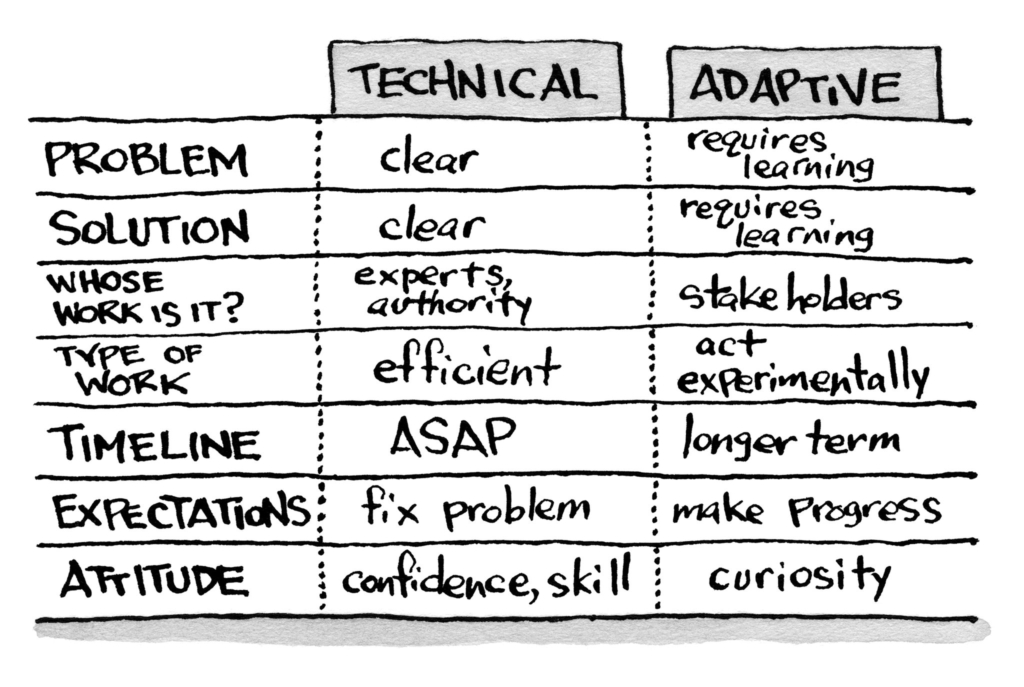Understanding Adaptive Leadership vs. Technical Solutions

What is Adaptive Leadership?
Adaptive leadership is a dynamic and transformative approach that focuses on navigating complex and systemic challenges. It requires flexibility, innovation, and the ability to mobilize people towards sustainable change.
Key Characteristics of Adaptive Leadership:
- Focus on Change and Transformation: Adaptive leadership addresses challenges that necessitate shifts in values, attitudes, and behaviors.
- Problem Identification: It involves recognizing adaptive challenges that are multifaceted and require systemic change.
- Engagement and Mobilization: Adaptive leaders engage stakeholders and mobilize groups to co-create innovative solutions.
- Experimentation and Learning: This approach fosters a culture of experimentation, learning from failures, and iteratively testing solutions.
- Flexibility: Adaptive leadership is marked by its openness to evolving strategies and flexibility in execution.
Examples of Adaptive Leadership:
- Addressing community health disparities through collaborative health initiatives.
- Leading cultural shifts within an organization to embrace diversity and inclusion.
- Facilitating community engagement for local economic development.
What is a Technical Solution?
Technical solutions involve applying established procedures, expertise, or technology to solve problems with clear and well-defined solutions. These solutions are based on existing knowledge and standardized processes.
Key Characteristics of Technical Solutions:
- Defined Problems and Solutions: Technical challenges have clear problems and well-established solutions.
- Expertise-Based: Solutions rely on specialized knowledge and technical expertise.
- Standard Procedures: Implementation follows established protocols and best practices.
- Efficiency and Accuracy: Technical solutions aim for efficiency, precision, and accuracy.
Examples of Technical Solutions:
- Implementing a new IT system or software upgrade to improve organizational efficiency.
- Performing a specific medical procedure to treat a known illness.
- Repairing infrastructure, such as fixing a broken water pipe or building a road.
Comparison: Adaptive Leadership vs. Technical Solutions
| Aspect | Adaptive Leadership | Technical Solution |
|---|---|---|
| Nature of Problems | Complex, systemic, and ambiguous challenges | Clear, well-defined, and straightforward problems |
| Solution Approach | Involves experimentation, learning, and adapting | Involves applying established procedures and existing knowledge |
| Focus | Change, transformation, and addressing root causes | Efficiency, accuracy, and resolving specific issues |
| Stakeholder Engagement | High level of engagement, collaboration, and mobilization | Limited to necessary technical experts and direct stakeholders |
| Flexibility | High flexibility, iterative testing, and openness to evolving strategies | Low flexibility, follows predefined steps and protocols |
| Examples | Systemic community health improvements, organizational culture change | Software upgrades, specific medical treatments, infrastructure repairs |
Why Adaptive Leadership Matters to RFL
At Roaring Fork Leadership, we prioritize projects that require adaptive leadership because these initiatives drive profound and lasting community impact. By fostering adaptive leadership, we help our participants and partner organizations address root causes of complex issues, engage communities in meaningful ways, and develop innovative solutions that stand the test of time.
Join Us in Making a Difference
If you have a project that requires adaptive leadership and addresses significant community challenges, we invite you to submit your proposal for our Civic Impact Projects. Together, we can create positive change and build a thriving community.
Learn More and Submit Your Project
For more information, contact us at andrea@rfleadership.org.